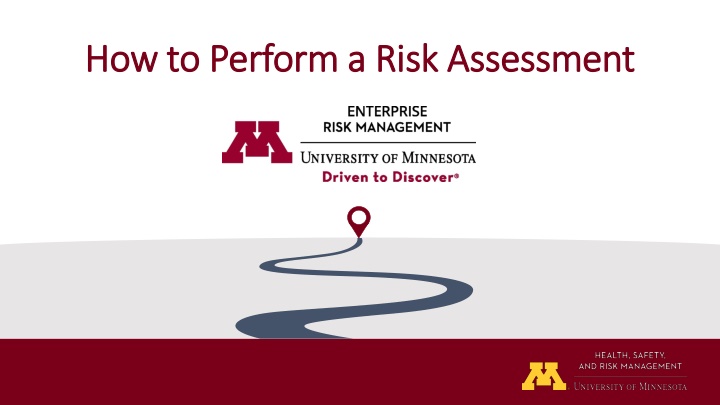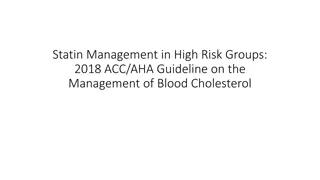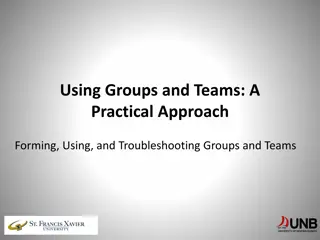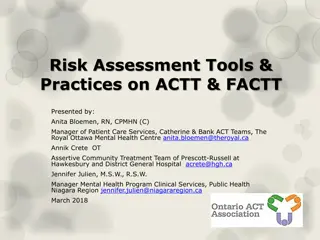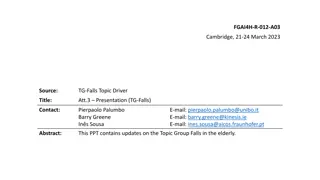Risk Assessment and Goal Setting for University Groups
Understanding how to perform a risk assessment is crucial for university groups to identify potential risks that could impact their goals and objectives. By considering possible outcomes, assessing risks, and setting achievable goals, these groups can minimize surprises and make informed decisions to align with the university's strategic objectives. Leveraging tools like Risk Self Assessment can aid in this process.
Download Presentation

Please find below an Image/Link to download the presentation.
The content on the website is provided AS IS for your information and personal use only. It may not be sold, licensed, or shared on other websites without obtaining consent from the author.If you encounter any issues during the download, it is possible that the publisher has removed the file from their server.
You are allowed to download the files provided on this website for personal or commercial use, subject to the condition that they are used lawfully. All files are the property of their respective owners.
The content on the website is provided AS IS for your information and personal use only. It may not be sold, licensed, or shared on other websites without obtaining consent from the author.
E N D
Presentation Transcript
How to Perform a Risk Assessment How to Perform a Risk Assessment
Risk Assessment Steps Risk Assessment Steps What is a risk assessment and why perform one? What is my goal? What could keep me from achieving my goal? What are the possible outcomes? What are my assumptions and are there correlations among drivers? Is my response enough? 5 1 2 3 4
What is a risk assessment and why perform one? What is a risk assessment and why perform one? Risk Assessment: The consideration of the extent to which potential events have an impact on the achievement of objectives. The assessment is done from two perspectives: impact and likelihood. It includes both positive and negative potential events. Why perform risk assessments? Minimize surprise and impact on operations and administration Aid in quick, risk-informed, decision making including allocating time and resources Allows risks to be prioritized and paired down for action All risks map back to strategic goals and priorities
What is my goal? What is my goal? 1 Consider the short and long-term goals and objectives of your group at the University. These may be official statements or implied. What does it mean to be successful? Its helpful to consider the University s three-part mission and the MPact 2025 strategic plan. How does your group contribute to the achievement of the system-wide goals?
What could keep me from achieving my goal? What could keep me from achieving my goal? 2 Falling short of a goal can result from many factors or events both internal and external to the University. These are your risks. Remember, risk represents uncertainty so risk can be negative or positive. A risk event may occur that provides an opportunity. A risk assessment should be done for each key risk or risk with the potential to have a significant impact on your goals. The Enterprise Risk Management group has created tools such as the Risk Self Assessment to help walk through the process.
What are the possible outcomes? What are the possible outcomes? 3 Best-Case Most-Likely Worst-Case After identifying risks to the achievement of your goals or objectives, consider the possible outcomes and scenarios should those risks occur. Look for the worst-case, best-case, most-likely scenarios, and possibilities in-between. The Enterprise Risk Management group has created simple tools assess and score risks in a consistent way.
Tools & Tools & Resources Resources Consistent risk analysis tools are available at institution and local levels with tools like this scorecard.
What are my assumptions and are there What are my assumptions and are there correlations among drivers? correlations among drivers? 4 Examine your assumptions when considering risk scenarios. Leaders may rely too heavily on their experience creating blind spots in an unpredictable and sudden environment. Consider relationships among risk drivers. Risk drivers are the causes or sources of risk such as market conditions, regulatory changes, or climate change. Risks are often interrelated affecting one another.
Is my response enough? Is my response enough? 5 Leaders respond to risk in many ways. Approaches include: Mitigation (controls): Controls generally include any action taken to reduce the impact or likelihood of a risk. Controls may include policies and procedures, preventative computer controls, management reviews, segregation of duties, training, and many others. Transfer (or Sharing): Unacceptable risk can be transferred from the University to another party such as an insurance company, outside service provider, or market participant through hedging transactions. Acceptance: There may be cases where a risk is acceptable without taking any action to reduce it. Avoidance: Leaders may decide the risk cannot be reduced to an appropriate level and therefore avoid the underlying activity entirely.
Effectiveness of my response Effectiveness of my response Its helpful to consider the potential impact of risks both before and after any responses you ve already taken. This helps define the what could go wrongs. Inherent Risk: The risk to an entity in the absence of any actions the institution might take to alter either the risk s likelihood or impact. Residual Risk: The remaining risk after management has taken action to alter the risk s likelihood or impact.
Mitigation Plan Mitigation Plan If the risk assessment results in the need to further mitigate the risk, a risk mitigation plan is needed. The Enterprise Risk Management group has created tools to help identify the various components of your mitigation plan. A proactive and risk-aware response will increase the likelihood you achieve your goals!
Thank you! Thank you! Please feel free to reach out with additional questions.
